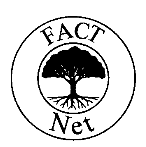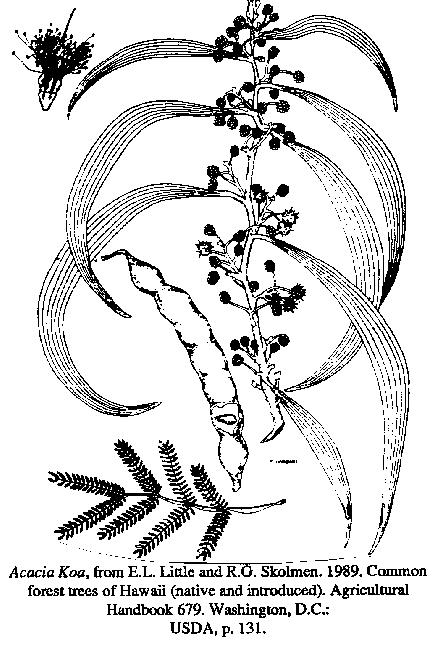Acacia koa – Hawaii’s most valued native tree

NFTA 94-08, September 1994
A quick guide to useful nitrogen fixing trees from around the world
Koa (Acacia koa Gray.) is unquestionably Hawaii’s most prized tree species- culturally, ecologically and economically. Hawaiians have always valued koa for its exceptionally beautiful and durable wood. It remains the premier Hawaiian timber for furniture, cabinetry, interior work and woodcrafts. Equally important, native koa forests provide unique wildlife habitat, critical watershed recharge areas and recreational opportunities. Unfortunately, forest clearing for agriculture, cattle grazing and feral pig activity have much diminished Hawaii’s once extensive koa forest. The scarcity of koa wood is reflected in its ever increasing price-high enough now to economically justify helicopter logging.

Botany and Ecology
Acacia koa is a large, evergreen broadleaf tree and the only Acacia native-and endemic-to Hawaii. Trees occurring in dense, wet native forest stands typically reach heights of 25 m and stem diameters (DBH) of 150cm, while retaining a straight, narrow form. In the open, trees develop more spreading, branching crowns and shorter, broader trunks. Koa bark is gray, rough, scaly and thick. Observa-tions indicate that koa has one main tap root – and an otherwise shallow, spreading root system.
Koa belongs to the thorn-less, phyllodinous group of the Acacia subgenus Heterophyllum (Whitesell 1990). Like other phyllodial species, mature koa trees do not have true leaves. Instead they produce phyllodes, or flattened leaf petioles. Young seedlings have bipinnate compound true leaves with12 to15 pairs of leaflets. Where forest light is sufficient, seedlings stop producing true leaves while they are small less then 2 m tall.
True leaves are retained longer by trees growing in dense shade. Phyllodes are sickle-shaped and often more than 2.5 cm wide in the middle and blunt pointed on each end. Investigations suggest that true leaves promote more rapid early growth when moisture is adequate, whereas phyllodes are better adapted to drought. Phyllodes transpire only 20 percent as much as true leaves, and their stomata close four times faster after dark. Phyllodes typically hang down vertically, a position that enhances their ability to capture light during early morning and late afternoon hours. Seedlings are able to switch back from phyllode to true leave production when the sunlight reaching them is reduced (Walters and Bartholomew 1990). This adaptation allows them to survive and grow under a wide range of light regimes.
Observations suggest koa can flower almost any time of year, depending upon local weather conditions. The inflorescence of koa is a pale yellow ball averaging 8.5 mm in diameter, one to three on a common stalk. Each inflorescence is composed of many bisexual flowers. Each flower has an indefinite number of stamens and a single elongated style. One known pollinator of koa is the honeybee (Apis mellifera). Koa appears to be fully self-fertile (Brewbaker 1977).
Koa pods are slow to dehisce and about 15 cm long and 2.5 to 4 cm wide. They normally contain between 6 and 12 seeds that vary from dark brown to black. Pods reach maturity at 4 to 6 months, depending on location and weather conditions. Insect larvae of many species typically destroy a large proportion of the mature seeds before they dehisce.
Seed production typically begins when trees are 5 years old. Koa bears seed often and abundantly. Seeds are seldom dispersed far from the tree and remain viable in the soil for up to 25 years. Thus remnant koa stands are capable of dominant regeneration under favorable conditions. Koa seeds do not require sunlight to germinate, but seedling growth is slow in dark understories or in thick grass. The species thus requires large forest gaps, such as those created by storms, to successfully regenerate.
Distribution
Acacia koa occurs at elevations from 180 to 6000 meters between 19 and 22 latitude on all of the major Hawaiian islands. It prefers an annual rainfall of 1900 to 5100 mm, and well drained acid soils. However, koa adapts to almost any of Hawaii’s diverse environments indicating its potential elsewhere in the Pacific. Koa is found on all volcanic soil types of all geologic ages. It grows well in moderately to well-drained, medium to very strongly acid soils on both flatland and steep slopes. On dry, shallow, poorly drained soils koa’s growth is slow and its form generally poor.
Occurring in both pure and mixed forest stands, koa is most commonly associated with the native ohia (Metrosideros polymorpha). It is also a codominant in several other major forest types including: Koa/Mamane(Sophora chrysophylla) Montane Dry Forest and Koa/Ohia/A’e (Sapindus soponaria) Forest (Wagner et al. 1990). Today Acacia koa stands are fragmented and concentrated in areas between 600 and 1800 meters elevation (Whitesell 1990). This distribution is largely the result of land conversion to agriculture and ranching. Cattle avidly graze koa seedlings, preventing regeneration.
Silviculture
Propagation is most successful from seed. One study recommends air-layering as the best vegetative propagation technique (Skolmen 1978). Koa seeds are durable and easy to store. They germinate after many years of storage if kept in a cool, dry place. The most effective method for improving seed germination is mechanical scarification. However, hot water soaking works well and is a more practical method. Boil water and remove it from the heat source. Soak seed in the boiled water for 24 hours. Once treated, seeds are typically sown in nursery beds. One week after germination, seedlings are transplanted into nursery tubes or bags. Seedlings are ready for transplanting into the field when they are approximately 20 cm tall-after 3 to 4 months in the nursery. Observations suggest that heart rot problems may be partially caused by root damage during transplanting. Therefore, establishment by direct seeding or encouragement of natural regeneration is recommended. On favorable sites, planted seedlings typically grow to 9 m in 5 years time (Judd 1920).
Koa’s wide branching form is the result of open growth. Trees with long clear boles-called “Canoe trees” by native Hawaiians are now rare, but still found in forest gaps created by fallen trees. Dense stocking of seedlings, which mimics the competitive environment where superior “canoe trees” grow, encourages straight and rapid height growth. Initial spacing of 1.2 x 1.2 meters is currently recommended. Observation indicates that effective self-thinning will result in an adequate number of potential crop trees by age 25.
Where scattered koa cover is adequate, plantation establishment is most easily and successfully accomplished through the stimulation of natural regeneration. Pasture soils are scarified and competition from grasses reduced by the application of a contact herbicide. Gaps in the regeneration are filled with planted seedlings. Fertilizers are applied to give seedlings an initial “boost”. Plantation thinning prescriptions should be based on desired products and management capabilities. The most important factors to consider in picking koa crop trees is stem form and height. Research on koa plantation management and various spacing and thinning regimes is direly needed.
Uses
Wood. Koa heartwood is highly valued by furniture and crafts people throughout Hawaii, and consumers the world-over, for its unique grain, varied color and workability. It seasons well without serious warping or splitting. Curly-grained wood, the result of both stress and genetics, is preferred over straight-grained wood. Wood color ranges from a subtle yellow to a striking dark red-purple. The specific gravity of koa wood averages .40, but with curly-grained wood can be as high as .65. Mature koa boles are commonly forking or fluting and often suffer from heart rot. These characteristics and wide branch angles limit its value as a large timber. Fortunately, these defects may be corrected through silviculture.
Forage and Wildlife Habitat. Cattle, sheep and pigs browse koa foliage aggressively, especially its juvenile leaves. Koa is spread geographically throughout Hawaii and thus offers a variety of wildlife habitats of diverse moisture regimes, soils and vegetative compositions. An overlay of a koa forest area map onto a forest bird “habitat island” map produced by Walker (1986) shows remarkable correlation.
Land Reclamation. Most koa plantations in Hawaii have been established to provide vegetative cover on sites degraded by decades of intense grazing. Where scattered koa already exists, seed stored in the soil will likely germinate if the soil is scarified and grass competition controlled.
Symbiosis
Acacia koa is nodulated by the slow-growing Bradyrhizobium spp. common in tropical soils. It nodulates heavily in a variety of soils, suggesting it is effective with a wide variety of Bradyrhizobia strains.
Pests and Diseases
Banana poka (Passiflora mollissima) is a fast growing vine that commonly outgrows and smothers young koa trees. Kikuyu grass (Pennisetum clandestinum), a dominant and extremely aggressive highland grass in Hawaii, is a major deterrent to the emergence of koa seedlings on cleared or formerly grazed lands. Successful koa plantation monoculture has historically been difficult to achieve due to associated insect and disease problems. Examples include the defoliating koa moth (Scotorythra paludicola) and a lethal “koa blight” first observed in 1988 on the island of Oahu.
References
Brewbaker, J.L. 1977. Final Report, Acacia koa project. Unpublished report on file at the Institute of Pacific Islands Forestry and University of Hawaii, Department of Horticulture, Honolulu, Hawaii.
Judd, C.S. 1920. The koa tree. Hawaii Forester and Agriculturalist 17(2):30-35.
Skolmen, R.G. 1978. Vegetative propagation of Acacia koa Gray. In Proceedings, Second Conference in Natural Sciences, Hawaii Volcanoes National Park, June 1-3, 1978, edited by C.W. Smith. p. 260-273.
Wagner, W.L., D.R. Herbst and S.H. Sohmer. 1990. Manual of the Flowering Plants of Hawaii. Vol. 1. University of Hawaii Press, Bishop Museum, Honolulu, Hawaii.
Walker, R.L. 1986. Koa and wildlife – An enduring relationship Unpublished paper on file at the Hawaii Division of Forestry and Wildlife, Honolulu, Hawaii.
Walters, G.A., and D.P. Bartholomew. 1990. Adaptation of Acacia koa leaves and phyllodes to changes in photosynthetic photon flux density. Forest Science 36(4):1050-1060.
Whitesell, C.D. 1990. Acacia koa Gray. In Silvics of North America; 2, Hardwoods. R.M. Burns and B.H. Honkala, Tech. Coordinators. Agricultural Handbook No. 654. USDA Forest Service, Washington, D.C.
This issue was written by Karl Dalla Rosa, Hawaii State Department of Land and Natural Resources, Division of Forestry and Wildlife, 1151 Punchbowl Street, Honolulu, Hawaii 96813.
